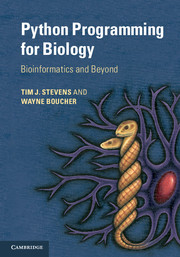Book contents
- Frontmatter
- Contents
- Preface
- Acknowledgements
- 1 Prologue
- 2 A beginners’ guide
- 3 Python basics
- 4 Program control and logic
- 5 Functions
- 6 Files
- 7 Object orientation
- 8 Object data modelling
- 9 Mathematics
- 10 Coding tips
- 11 Biological sequences
- 12 Pairwise sequence alignments
- 13 Multiple-sequence alignments
- 14 Sequence variation and evolution
- 15 Macromolecular structures
- 16 Array data
- 17 High-throughput sequence analyses
- 18 Images
- 19 Signal processing
- 20 Databases
- 21 Probability
- 22 Statistics
- 23 Clustering and discrimination
- 24 Machine learning
- 25 Hard problems
- 26 Graphical interfaces
- 27 Improving speed
- Appendices
- Glossary
- Index
- Plate section
- References
17 - High-throughput sequence analyses
Published online by Cambridge University Press: 05 February 2015
- Frontmatter
- Contents
- Preface
- Acknowledgements
- 1 Prologue
- 2 A beginners’ guide
- 3 Python basics
- 4 Program control and logic
- 5 Functions
- 6 Files
- 7 Object orientation
- 8 Object data modelling
- 9 Mathematics
- 10 Coding tips
- 11 Biological sequences
- 12 Pairwise sequence alignments
- 13 Multiple-sequence alignments
- 14 Sequence variation and evolution
- 15 Macromolecular structures
- 16 Array data
- 17 High-throughput sequence analyses
- 18 Images
- 19 Signal processing
- 20 Databases
- 21 Probability
- 22 Statistics
- 23 Clustering and discrimination
- 24 Machine learning
- 25 Hard problems
- 26 Graphical interfaces
- 27 Improving speed
- Appendices
- Glossary
- Index
- Plate section
- References
Summary
High-throughput sequencing
Given the decreasing cost required to determine the sequence of nucleic acids, sequencing is used in increasingly wider contexts. Rather than only determining the genome sequence of an organism, high-throughput techniques allow researchers to investigate much more, such as the variation within individuals of a population, the amount of expression of individual genes in a given sample (e.g. by detecting RNAs) and the sequences which are bound to particular protein components. A sequencing run on one of the latest-generation sequencing machines may generate many gigabases (>109 bp) of data and so much of the task for bioinformatics is to make sense of the raw sequence data: to put it into a genomic, biological context. For organisms with a known genomic sequence the primary task when processing high-throughput sequence data is to simply map relatively short bits of sequence called ‘reads’ that come from the sequencing machine to a reference genome. Only then can the detected sequences be understood. By mapping newly acquired sequences on to the known chromosomes the whole database of information that annotates the genome, such as the position of genes and regulatory sequences, indicates which DNA features were detected. In this chapter we will give an introduction to various basic computational procedures involving high-throughput sequence data which can be achieved, or at least handled, using Python. Because this is a vast and rapidly expanding subject we can only lightly touch on the core concepts here, though hopefully we have provided solid starting points for further development.
- Type
- Chapter
- Information
- Python Programming for BiologyBioinformatics and Beyond, pp. 341 - 360Publisher: Cambridge University PressPrint publication year: 2015



